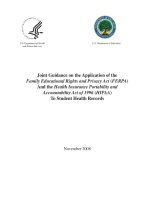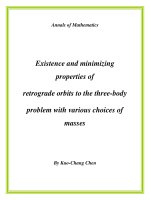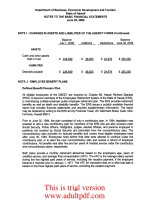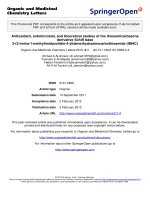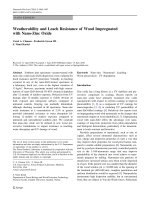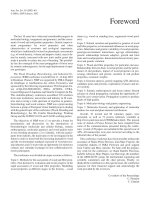Thermal combustion and oxygen chemisorption of wood exposed to low temperature long term heating 1
Bạn đang xem bản rút gọn của tài liệu. Xem và tải ngay bản đầy đủ của tài liệu tại đây (110.04 KB, 25 trang )
Chapter 1: Introduction
________________________________________________________________________
1
Chapter One: Introduction
1 Introduction
The significance the propensity of wood to combust spontaneously is that
spontaneous combustion of solid materials has always been one of the major hazards in
construction, transport, processing and mining industries (Wang, Dlugogorski and
Kennedy 2006). Spontaneous combustion involves ignition within bulk porous solid by
heterogeneous oxidation; self-heating arises as a result of low-temperature exothermic
reactions, or condensation of moisture. The exothermic reactions and moisture adsorption
occur on both the outside surfaces of the porous system as well as the intra-particle pore
surfaces within the system. Porosity and oxidizability are fundamental qualities of
materials that exhibit spontaneous combustion.
Babrauskas (2001) has differentiated self-heating, thermal runaway and spontaneous
combustion as a means to designate, as well as to explain, the different extent of
autoignition the materials exhibit. On the other hand, spontaneous ignition within bulk
solid encompasses the succession of these three events. Spontaneous combustion begins
with the incipient spontaneous oxidation brought upon by chemical, biochemical or
physicochemical processes; ignition within solid commences once the rate of heat
generation exceeds the rate of heat dissipation to the surrounding (Walker, Taylor and
Ranish 1991). The ultimate state is smoldering combustion, and when conditions are right,
Chapter 1: Introduction
________________________________________________________________________
2
transition to flaming combustion. For this reason, spontaneous combustion is delineated
to include all three stages of the process: the initial self-heating, autoignition and flaming
or glowing combustion; the same approach is undertaken by Wang, Dlugogorski and
Kennedy (2006).
In nature, coal, charcoal and carbon black are materials that are well known for their
propensity to self-heating and auto-ignition, even at temperatures close to the ambient.
These types of carbon materials have in recent years come to be termed as “pyrophoric”
materials (Babrauskas, 2001). Pyrophoric materials, whether in gas, liquid or solid form,
are materials that self-ignite below room temperature, according to International Building
Code 2006. Typical examples of pyrophoric materials include silane and phosphine gas,
liquid diethylaluminium chloride and reactive substances such as cesium, plutonium,
potassium and rubidium. The probable reason the carbonized materials have recently
been associated as pyrophoric materials could be due to the tendency of these materials to
ignite at low temperatures. The propensity of coals to combust spontaneously is
underscored by their chemical composition such as the rank of coal and the percentage of
fixed carbon, and enhanced by high porosity and hygroscopic adsorption of moisture
(Bowes 1984, Cuzzillo 1997, Wang, Dlugogorski and Kennedy 2003a). In addition, the
geometry of the solid that determines the access of oxygen plays an important role in the
spontaneous combustion of this class of pyrophoric carbon. If the coal has been
stockpiled in a compact manner, allowing no room for oxygen access, self-heating could
be delayed. Bowes (1984) has made an excellent review on the configuration of
stockpiling of charcoal for shipping to minimize self-heating. On the other hand, wood
Chapter 1: Introduction
________________________________________________________________________
3
generally is not pyrophoric, although cellulose can undergo direct oxidation at low
temperatures (Moussa, Toong and Garris 1976), but these reactions are very slow.
However, when wood has been exposed to prolonged heating, even at low temperatures,
they become more prone to combustion – a phenomenon that has gained acceptance
based upon fires originating from the ignition of wood and other cellulosic materials that
have come into contact with low pressure steam pipes and hot water pipes (Babrauskas
2001). The wood members were noted to spontaneously ignite after 3 months to 15 years
after installation (Bixel and Moore 1910, Matson, Dufour and Breen 1959). It has since
been hypothesized that low-temperature, long-term heating of wood leads to the
formation of pyrophoric carbon, where these partially carbonized wood would ignite
more readily at low temperatures than virgin wood (Ranke 1873).
Pyrophoric char and chemisorption
The conversion of wood to pyrophoric carbon occurs after prolonged heating. Walker
(1967) believed that prolonged exposure reduced the induction period for ignition to
occur. According to Walker (1967), extended storage at relatively high temperature
enabled oxidation reactions to pass through the period of induction and thus attain a rapid
rate of chemical heating; but exactly how oxidation is accelerated was not explained.
There are cases of practical importance in built environment that provide evidences to
such claims. Examples include wooden panels and beams that are exposed to flue pipes
(McGuire 1969), wood members that have been exposed to high intensity radiation
lighting
i
i
Ming Pao News, Hong Kong (13 Nov 2007) reported that a fire broke out on wood cabinet due to high-
intensity lighting; source:
and storage of fibreboards (Frangi, Fontana and Schleifer 2005).
www.npinews.com
Chapter 1: Introduction
________________________________________________________________________
4
From the chemical viewpoint, there must be certain chemical process responsible for the
exothermic reaction in pyrophoric wood that causes it to ignite. Bradbury and Shafizadeh
(1980a) have identified chemisorption of oxygen onto the partially carbonized wood to be
a significant factor in controlling the solid phase combustion. Their experiments showed
that heat generated by initial oxygen chemisorption is sufficiently intense to induce
ignition at lower temperatures for chars prepared under anaerobic conditions. Indeed,
oxygen chemisorption has long been identified as the primary reaction responsible for
spontaneous combustion of coal chars that are prepared at severe conditions (e.g. high
temperature) or from synthetic carbons (e.g. Saran char) (Teng and Hsieh 1999).
However, the kinetics and mechanisms for coal chars chemisorption are on the basal
planes, while these mechanisms are probably not dominant in the more amorphous wood
chars (Bansal, Vastola and Walker 1970); these two classes of carbon chars are entirely
different in chemical functionality and morphology. Different types of active sites,
chemical functional groups and reaction pathways are responsible for chemisorption of
oxygen onto wood chars. Chemisorption studies on low temperature wood char would
therefore focus on characterizing the hazardous properties that promote chemisorption
and determining the conditions that facilitate it. In doing so, it becomes important to
elucidate the kinetics of oxygen chemisorption in order to evaluate the autoignition
potential of low temperature wood chars that have been pre-exposed to prolonged heating.
Thermal models
To completely understand spontaneous combustion, no mathematical treatment is ever
enough to deal with the complexity of phenomena involved. Research in solid-phase
Chapter 1: Introduction
________________________________________________________________________
5
combustion phenomena includes modeling chemical reactions beyond a single chemical
reaction represented in Arrhenius form; secondary reactions that arise from interaction
between the primary pyrolysis products; char oxidation mechanism and deformation such
as fissuring, shrinkage and cracking (Di Blasi 1993). Access of oxygen and adsorption of
moisture further complicates the solid-phase model with pore opening and closure.
Simplifications of varying degree have to be made in order to keep the mathematical
treatment tractable. Sometimes, simple models that neglect all chemical effects and are
purely thermal offer an analytical framework for an otherwise hopelessly complex
problem.
Thermal explosion theory is and remains important in that regard for the investigation of
spontaneous combustion of wood (Bowes 1984, Blomqvist and Persson 2003, Wang et al.
2006). This is because an investigation on chemisorption may be plausible from a
chemical viewpoint, but the proposition would collapse under physicochemical
framework if the reaction could not generate sufficient heat or the heat generation is less
than the heat loss in the bulk solid, both of which would not result in an ignition.
Thermal explosion theory was first developed for spontaneous ignition or autoignition of
gases by Semenov (1940) where he observed a critical ignition temperature for
flammable mixtures. Semenov model deals with situations involving low Biot number
where the heat conduction inside the system is much faster than the heat conduction away
from its surface; temperature gradient is therefore negligible inside the system. Heat
losses are controlled by convection from the surface to the surrounding atmosphere.
Chapter 1: Introduction
________________________________________________________________________
6
Frank Kamenetskii (1969) developed a high Biot number model (Bi > 10) of thermal
explosion where heat losses within the system are controlled by thermal conductivity, and
that the temperature of the surface and the ambient temperature are equal. Both models
are mathematical treatments of the critical heat balances between heat generation and
heat dissipation during thermal explosion of reacting materials. However thermal
explosion of gases, where Semenov model was originally developed for, involves very
short induction period in the order of milliseconds. In that regard, Semenov model cannot
be applied to the spontaneous combustion of bulk solid, where the induction period varies
between hours, days or weeks, depending on the mass and storage temperature (Drysdale
1985). Babrauskas (2001) noted the long induction period involving weeks and months
for spontaneous combustion of wood-based members. Frank-Kamenetskii model has
been applied to study the thermal explosion of bulk solid. Examples include chemically
activated carbon powders prepared in cubical baskets with side length ranging from
25.4mm to 610mm (Bowes and Cameron 1971), aluminum residue packed in cubic
baskets with side lengths of 51, 76 and 102mm (Hill and Quintiere 2000) and 89mm cube
of cooked and uncooked wood blocks, chips and sawdusts (Cuzzillo 1997). In addition to
Semenov model and Frank-Kamenetskii model, Thomas (1958) developed a model that
embodied both theories by Semenov (1940) and Frank-Kamenetskii (1969) to deal with a
system involving conduction through solid and convective heat loss from the surface.
Walker (1967) introduced the notions of dry combustion and wet combustion in the
context of spontaneous combustion of solids. Dry combustion is related to fires
originating from stacking of hot, dry sheets of fiber insulation boards directly from
Chapter 1: Introduction
________________________________________________________________________
7
production line or hot linen piled in large baskets immediately after removal from
industrial tumble driers. According to Walker (1967), water does not have a dominant
role in thermal explosion by dry combustion; size effects and shape of solid are inter alia
the more critical factors (Bowes 1984, Cuzzillo 1997). The effect of water is restricted to
heat of wetting (Walker 1967), which can, under certain circumstances, raise the
materials above room temperature, enabling spontaneous combustion to begin; but
exactly how water could act as a trigger mechanism in dry combustion has not been
explained. Thomas (1973) proposed an approximate theory of “hot spot criticality” to
deal the spontaneous ignition that may arise from this type of storage of large quantities
of hot materials in a cool environment.
This study is interested in the notion of wet combustion which can be associated with
spontaneous ignition in air-dry materials where the migration of bound water in air-dry
materials can have an effect on the ignition process. Wood is hygroscopic; in air-dry state,
bound water amounts to 10% by mass in equilibrium with common atmospheres (Walker
1967). Coals that are prone to spontaneous heating also contain appreciable amounts of
water in air-dry state (Davis and Byne 1926a). When a hygroscopic solid naturally prone
to exothermic reaction is considered, it is the availability of moisture and it consequential
effects that render it liable to spontaneous ignition by self-heating mechanism (Walker
1967, Babrauskas 2001). This is because materials such as cellulose will undergo
heterogeneous oxidation more rapidly when liquid water is present, thus generating heat
at lower temperatures than would the dry material. Wet combustion is also concerned
with the control of heat balance by thermal conductivity, and the operative value of
Chapter 1: Introduction
________________________________________________________________________
8
thermal conductivity that is dependent on the amount of moisture present. For
spontaneous ignition in wet haystacks, the mass transport of water vapour causes high
thermal conductivity; heat is dissipated and ignition is inhibited. It is interesting to note
that Frank-Kamenetskii model that has been commonly applied for spontaneous ignition
of wood actually does not provide for water evaporation or migration of moisture in the
model (Wang et al. 2006).
1.1 Research problems
Spontaneous combustion in wood in its simple form is thermal explosion caused
by wet combustion, rather than dry combustion (Walker, 1967). The revisited approach
brings out the importance to redress the role of moisture, the evaporation and the
associated heat and mass transfer mechanisms which are fundamental to a thermal model.
This section examines these issues in turn and seeks to elucidate the research problems
for each term.
1.1.1 Evaporation for low-temperature prolonged drying
In models that considered water evaporation, evaporation has been treated as a
source term in the energy balance. Because evaporation is an endothermic process, the
source term thus becomes a heat sink. The incorporation of an internal evaporation term
would result in heat drawn from inside the system. This approach does not differentiate
evaporation that occurs at low temperature drying and that of high temperature heating.
Chapter 1: Introduction
________________________________________________________________________
9
Consider wood that is heated at low temperature, or low heating rate; assuming that wood
is initially at room temperature and is at its equilibrium moisture state, radiative heat flux
and/or convective hot air causes evaporation at the surface. Heat is conducted inwards;
temperature of the solid slab starts to increase until it reaches boiling point, where heat is
consumed at latent heat. Evaporation takes place almost entirely at the surface; this is the
evaporation model concurring with initial stage of drying when wood is heated from
room temperature.
When wood is continuously heated for a long time, or exposed to high heating rate of
which moisture evaporation is fast and rapid, diffusivity of water reduces to a level where
outflowing water flux becomes smaller than the rate of surface evaporation. As a result,
evaporation front begins to retreat from the surface and advances inwards. Evaporation
now takes place inside the system where there is a large gradient of moisture content.
This is the phenomenological evaporation model for high-temperature heating or drying
that has occurred at the advanced stage (Ilic and Turner 1986). The two different
evaporation models are illustrated schematically in Figure 1.1 and 1.2.
Chapter 1: Introduction
________________________________________________________________________
10
Figure 1.1: Evaporation model for low-temperature drying: water flows to the surface
where evaporation takes place and consumes heat from the ambient hot air.
Figure 1.2: Evaporation model for high-temperature drying: evaporation occurs
throughout the material and is the same amount as the mass change rate of total moisture.
Moisture loss is realized by changing to vapour and then vapour moving to the material
surface
Moisture diffusion
Heat conduction
Zone C
Zone B
Zone A
Latent
heat
Vapour
Moisture diffusion
Heat conduction
Zone C
Zone B
Zone A
Heat from hot air
Latent
heat
Vapour
Chapter 1: Introduction
________________________________________________________________________
11
The initial drying evaporation model (hence known as “Model 1”) and the high
temperature drying evaporation model (hence known as “Model 2”) represent two
different physical processes of evaporation. The incorporation of evaporation as an
internal heat sink in the energy balance is a mathematical description of Model 2. The
underlying assumption that evaporation occurs within wood is also fundamental to the
conventional high temperature model proposed by Alves and Figueiredo (1989). By
incorporating an internal evaporation term (Chan et al. 1985; Fredlund, 1988; Alves and
Figueiredo, 1989; Yuen, 1998), which has been common practice for pyrolysis models
used to study woods burning in fire, the models have avoided low-temperature drying
evaporation completely. The consequence of adopting an internal evaporation term may
not be obvious for combustion phenomenon in high temperature heating regime.
However, for wood combustion phenomenon occurring at low temperature drying regime,
or exposed to low heating rate, the impact is discernible in a different temperature
distribution (See Figure 1.3).
Model 1 produces a uniform temperature distribution. This temperature profile concurs
with drying at initial stage where thermal conductivity is relatively large due to the
presence of moisture content. In Model 2, since heat is drawn from inside wood, it creates
a heat sink; temperature inside wood is lower and it creates a temperature gradient for
which to maintain the influx of heat from the surface. The depressed temperature curve
does not reflect the right temperature distribution that involves evaporation that occurs at
the surface.
Chapter 1: Introduction
________________________________________________________________________
12
Figure 1.3: Temperature profile using Model 1 and Model 2 during initial period of
wood drying
46
50
54
58
1.00 1.01 1.03 1.04 1.05 1.06 1.08 1.09 1.10 1.12
Distance from centre (mm)
Temperature (
o
C)
Model 2 Model 1
(Graph taken from Zhang and Datta (2004), Copyright ©Drying Technology)
For wood drying at low temperature, it requires a different description of moisture
evaporation. An alternative formulation is needed to represent evaporation which occurs
at the surface, before evaporation front retreats from wood surface. The low-temperature
evaporation model seeks to address some problems associated with low-temperature
combustion phenomenon by firstly restoring moisture for low temperature heating where
high temperature evaporation model would have rapidly vaporized the moisture; secondly
redressing the importance of moisture flow at low temperature regime which has been
surpassed by high temperature heating model.
Chapter 1: Introduction
________________________________________________________________________
13
1.1.2 Liquid water transport modelling
High temperature drying model does not consider liquid water transport, and
moisture flow takes place essentially in vapour phase (Fredlund, 1988; Alves and
Figueiredo, 1989; Yuen, 1998). The model bases its argument on that there is no
continuous water phase at moderate moisture content to support liquid movement. Indeed
the evaporation rate in high-temperature drying is tantamount to the same amount of
mass change rate of total moisture. In other words, there is no liquid water movement.
Following the discussion, research shows that there are three distinct stages for wood
drying based on wood moisture content (Eriksson, Johansson and Danvind 2007). The
stages can be defined as
is
Stage 1 X X≥
is fsp
Stage II X X > X>
(1.1)
fsp
Stage III X > X
where X denotes the moisture content in wood, X
is
is the moisture content where the
continuity of liquid phase breaks down and X
fsp
is the fiber saturation point.
First stage of wood drying is almost non-existent since wood generally has moisture
content below free water continuity (<X
is
) even at green condition (Siau, 1984). Wood
Chapter 1: Introduction
________________________________________________________________________
14
drying models deal with stage II – where moisture content of wood is bound between free
water continuity and fiber saturation point. The true mechanisms for moisture transport at
stage II are still open for discussion, but Perré at al (1993)successfully modelled both
liquid and gaseous support while Krabbenhøft (2003) pointed out that there is certain
justification for assuming transport of free water under partially saturated conditions.
Alves and Figueiredo (1989) have made assumptions on moisture flow in wood based on
a model which divides wood into two regions separated by an isothermal plane – the
100°C plateau as the plane of vaporisation. The rate of at which this plane moves at any
depth
x
is assumed to depend upon only the net rate of heat transfer by conduction.
Analysis using the model shows that free-water is always important in the longitudinal
direction, and emphasises that this assumption is NOT valid for moisture content above
free water continuity. The finding agrees with the drying of pine wood at low pressures
(Moyne and Martin, 1986) and that in high temperatures (Basilico and Martin, 1984). But
Alves and Figueiredo (1989) contradicted their own findings by assuming otherwise –
that by not describing free water movement in a drying model, the model’s validity range
is reduced to below free water continuity. The reason for such contradictory assumption
is unknown and is not supported by studies of moisture flow at stage II drying carried out
by Perré at al (1993) and Krabbenhøft (2003).
In low temperature drying model of wood, there is a stronger reason to restore free water
movement since drying would be slower and there would be measurable movement of
free water during this stage. It has been pointed out that most of the work on the onset of
convection in porous media (with or without chemical reaction) has assumed the fluid in
Chapter 1: Introduction
________________________________________________________________________
15
the basic equilibrium state is motionless (Gatica, Viljoen and Hlavacek 1989). However,
with the presence of both thermal and concentration effects, the existence of fluid density
gradients can eventually induce natural convection of fluid. In model that includes
pyrolysis, chemical reaction will set off further natural convection. In low temperature
drying model where moisture is dominant, it is necessary to include free water movement
as liquid water transport.
It has been widely assumed reasonable in high temperature drying model to divide
moisture flow into a vapour flow and a water flow (Claesson and Gaffner 1977). This
assumption is endorsed on the basis that for drying associated with rapid heating, heat
flow is different from the total energy flow. There is however no reason for low-
temperature drying model to divide the moisture flow. An alternative formulation is to
combine the vapour and moisture flow into a total flow; a combined flow has been
adopted by Zhang and Datta (2004) for both low and high temperature drying. The
combined approach has also been shown to produce satisfactory results for high-
temperature drying (Lianbai and Ping 2003, Ping and Lianbai 2003). A combined
approach is hence adopted in the formulation of the low-temperature drying model to first
re-introduce free water movement into the system, and second to more accurately reflect
the low-drying regime which does not normally divide the moisture flow unlike that in
high-temperature drying model.
Chapter 1: Introduction
________________________________________________________________________
16
1.1.3 The effects of moisture on thermophysical terms
Spontaneous ignition within bulk solids is often handled using Frank-Kamenetskii
model as discussed in Section 1: Introduction under sub-heading: thermal models.
Momentum transfer equations are decoupled from the energy and mass balances for
thermal explosion models– an approach introduced by the Russian school (Zel'dovich and
Frank-Kamenetskii 1938, Frank-Kamenetskii 1969), of which the Frank-Kamenetskii is
one of the thermal explosion models. In thermal explosion models, only heat conduction
is considered, and no other physical processes, such as water evaporation, are deemed to
make a significant contribution to the energy balance.
Dry materials that are involved in spontaneous ignition are hygroscopic (Walker, 1967);
these hygroscopic materials, including wood, contain certain equilibrium amount of
moisture depending on the temperature and humidity of the atmosphere. The contained
moisture plays an important part in the self-heating of these hygroscopic materials in air-
dry state. (Walker 1967). Walker detailed the effects of water on the heat balance during
ignition in his excellent review of the role of water in spontaneous combustion of solids.
The presence of moisture in a hygroscopic material will raise the thermal conductivity by
a direct effect on density. Moisture also raises the thermal conductivity by mass transfer
mechanism where the temperature difference within bulk wood causes stratification of
water vapour concentration, resulting in mass transfer of water vapour from hot zones to
cold zones, carrying with it the latent heat of vaporization. The net effect is a very large
Chapter 1: Introduction
________________________________________________________________________
17
temperature coefficient of effective thermal conductivity in porous solids (Sahota and
Pagni 1979). Thermal diffusivity also increases concomitantly because of the enhanced
distribution of latent heat by diffusing water vapour, in addition to sensible heat
conduction (Henry 1939, Henry 1948). Besides, the presence of moisture also affects
effective specific heat of a porous material as the temperature changes. Evaporation of
moisture can slightly raise the apparent specific heat because of the large latent heat of
vaporization; this change in apparent specific heat is however negligible if the interstitial
atmosphere is static i.e. porosity remains constant (Walker and Harrison 1960). This
increase in specific heat also leads to an increase in thermal diffusivity of the system.
When water is adsorbed as condensed vapour, latent heat of vaporization is added to the
heat of wetting, producing a temperature rise. Heat of wetting has been shown to enhance
oxidative temperature when dry coal is ventilated with moist oxygen (Davis and Byne
1926b, Stott 1960, Wang et al. 2003a); degraded cellulose also undergoes exothermic
reaction with oxygen more rapidly when wet than when dry (Walker, 1967); porous
oxidizable materials such as coal (Wang, Dlugogorski and Kennedy 2002, Wang,
Dlugogorski and Kennedy 2003b), charcoal (Yu and Sotirchos 1987), hay (Rothbaum
1963) and wool (Dye and Rothbaum 1964) react with oxygen more rapidly when wetted.
Adsorbed moisture thus plays an important role on low-temperature heterogeneous
oxidation of common organic materials, where heat of wetting acts as the trigger
mechanism for wet combustion. Many researchers (Hedges 1926, Berkowitz and Schein
1951), (Wang et al. 2003a, Wang et al. 2003b) have suggested that heat of wetting acts to
raise the temperature to a point where other exothermic reactions can take place;
Chapter 1: Introduction
________________________________________________________________________
18
sometimes, heat of wetting might raise materials to full combustion (Hedges 1926,
Berkowitz and Schein 1951).
The foregoing discussion suggests that the presence of moisture in the bulk material will
change the thermophysical properties including thermal conductivity, specific heat
capacity, thermal diffusivity, and heat of wetting, in a way that enhances heat transfer,
even without mass transfer mechanism. Williams (1953) for instance has shown that
moisture migration is negligible in the heat transfer of woods with different moisture
contents up to 30 percent and at intensities of radiation between 83.7 kW/m
2
and 129.8
kW/m
2
using a graphite panel furnace. It has been shown that for thermal models, by
providing for changes in thermophysical properties corresponding to the appropriate
moisture content, the temperature rise of wood can be successfully correlated with its
thermal properties, without having to consider moisture migration (Williams 1953,
Gardon 1953).
In this study, the effects of moisture on spontaneous ignition of wood are evaluated by
providing for corresponding changes in thermophysical properties of wood within the
framework of thermal models. The value of thermal constants, heat of wetting and latent
heat of vaporization will be considered within the term of specific heat. Thermal
conductivity will be related to density changes that vary with moisture content.
Evaporation of water is important, but evaporation modeling will not be included in the
thermal model since the ignition criterion is not based on minimum pyrolysis rate
(Janssens 1991a). By incorporating moisture-mediated thermophysical properties,
Chapter 1: Introduction
________________________________________________________________________
19
correlation of ignition data can be evaluated for moisture effects in thermal models, even
though moisture migration is not included.
1.1.4 Oxygen chemisorption for cellulosic chars
Prolonged exposure of wood char to the atmosphere affects its combustion
properties. While surface oxidation, driven by chemisorption is the exothermic reaction
responsible for pyrolysis and smoldering combustion, the adsorption of water vapour
onto char also affects the chemisorption process (Allardice 1966). The propensity of
wood char to ignite spontaneously can not therefore be evaluated in a single aspect of the
processes independently of the other.
The adsorbed water exerts a partial pressure of vapour which will reduce the partial
pressure of oxygen in the interstitial atmosphere within the porous slab. As temperature
increases, the rising partial pressure of water vapour causes the partial pressure of oxygen
to fall, which eventually reaches zero at 100°C. These changes in oxygen partial
pressures will change the rate of any chemical reaction of order greater than zero, in
which oxygen may participate (Walker, 1967). Other than its effects on partial pressure,
moisture also affects chemisorption through prior desorption of moisture on gaseous
oxidation. A theory has been advanced that surface prone to react with oxygen can be
protected by a film of adsorbed carbon dioxide, and that adsorption and subsequent
desorption of water might displace this film (Walker, 1967). Some support of this theory
Chapter 1: Introduction
________________________________________________________________________
20
is provided by experiments in which powdered graphite became pyrophoric after
immersion in argon followed by desorption (Degroot, Osterheld and Richards 1991).
In this study, the kinetics of chemisorption have been investigated for wood chars without
surface desorption in order to evaluate the effects of moisture on the autoignition
potential during temporary storage and handling. Researchers remain disparate on the
view whether combustion behaviour can be correlated with chemisorption kinetics.
Harker Gallagher and Parkin (1966) studied the role of unpaired electrons in carbon
oxidation and found that the mechanism for catalysis of combustion is separate from the
chemisorption. In a later study by Degroot and Shafizadeh (1983), it was found that the
addition of inorganic additives did not affect either the chemisorption and pyrolysis
kinetics and hence concluded that the two processes were correlated. No conclusive
evidence can however be established. Therefore, chemisorption kinetics is also examined
in its own rights as a parameter for determining the reactivity of surface oxidation.
Chemisorption kinetics is studied to determine the types and distribution of active sites in
wood chars, which are believed to be different from that in coal. The distribution of
activation energy for chemisorption is determined to obtain the information on the active
sites responsible for the chemical aspect in the spontaneous combustion of wood chars.
Chapter 1: Introduction
________________________________________________________________________
21
1.2 Research objectives
Following the research problems formulation, this study aims to
1. Investigate the role of moisture on ignition within the thermophysical framework
of a thermal model, where the effects of moisture transport is decoupled and only
pure conduction is allowed. Despite negligible moisture migration, the presence
of moisture in hygroscopic wood plays a dominant role through heat transfer.
Moisture effects on ignition are examined through moisture-mediated
thermophysical terms on a revised thermal model for evaluating the ignition data
of wood.
2. Explore the interaction between fluid transport on temperature field development
so as to examine the role of moisture transport on self-heating and spontaneous
combustion of wood. Long-term, low-temperature drying brings upon the
transport of liquid water as well as the diffusion and convection of vapour within
wood volume that would otherwise be surpassed in high temperature drying or
fast heating scenarios. The role of moisture transport and its interaction with
temperature field development is therefore investigated using a porous medium to
assess its contribution towards spontaneous combustion in wood.
Chapter 1: Introduction
________________________________________________________________________
22
3. Elucidate the most suitable approach to represent evaporation in low-temperature,
long-term drying of wood. The low heating rates and extended heating times
permit altogether different conditions for evaporation to approach water-vapour
equilibrium as compared to high-temperature drying model. A low-temperature
drying model would entail different treatment of evaporation during the initial and
late drying phases as evaporation front recedes from the surface towards the
internal zone within wood.
4. Evaluate the propensity of self-heating in wood char from the chemical viewpoint.
Oxygen chemisorption is carried out to study the reactivity of low-temperature
wood chars. Derivation of Elovich constants and activation energy characterize
the active sites that are responsible for oxygen chemisorption in wood chars – an
amorphous carbon which is chemically different from the graphitic coal chars.
The objective of chemical investigation is to provide a chemical insight besides
the thermophysical explanation on self-heating of wood chars.
1.3 Scope of work
Taking into consideration of the above objectives, the focus of this thesis is on
thermal combustion and oxygen chemisorption of preheated wood at low temperature,
long-term heating. The scope of work and the structure of discussion in each chapter are
described as follows:
Chapter 1: Introduction
________________________________________________________________________
23
• Review and formulation of research problems. Chapter One discusses research
problems central to wet combustion of wood and the mathematical considerations of
the various components in wood combustion. Research problems are then formulated
by revisiting key issues pertaining to low-temperature, extended heating of wood:
evaporation, liquid water transport, moisture effects on thermophysical terms and
oxygen chemisorption.
• Literature review of main approaches for internal evaporation. Evaporation is
considered to occur at the surface and within the volume depending on the phases of
heating. Hence, Chapter Two reviews the different approaches for formulating an
internal evaporation term for the prolonged drying phase, when the surface
evaporation at the initial phase has recessed into the internal volume. Besides, the
thermophysical processes and the kinetic models forming the mathematical construct
are also reviewed. The chemical aspect of oxygen chemisorption is reviewed in
Chapter Five.
• Formulation of mathematical models for thermal combustion. To investigate the
thermophysical and thermodynamics aspects of water on spontaneous combustion of
wood, a porous model is formulated in Chapter Three. Modification to Darcy’s law is
incorporated to investigate the coupled heat and mass transfer due to water and
vapour in wood on the temperature development. Two-phase model are proposed: the
initial drying phase (IDP) model is formulated with surface evaporation and the
extended drying phase (EDP) model carries an internal evaporation term.
Chapter 1: Introduction
________________________________________________________________________
24
• Experimental design for spontaneous heating and Cone Calorimeter ignition
tests. Following the formulation of mathematical models for investigating thermal
combustion, Chapter Four describes the experimental design to investigate the
spontaneous combustion of wood in an isothermal oven exposed to low temperature
heating. Cone Calorimeter testing is carried out to examine the effects of moisture on
thermophysical aspects of wood ignition by exposing oven-dry green wood and
preburn wood slabs to various incident heat fluxes. Times to ignition and surface
temperatures are measured for both piloted and spontaneous ignition modes.
• Methodology and experimental design for oxygen chemisorption. Chapter Five
reviews and develops mathematical models on oxygen chemisorption. Experimental
design for oxygen chemisorption includes testing two types of chars; inert wood chars
and air-preheated wood chars. The chemisorption isotherms are analysed for the
Elovich constants and activation energy determined to evaluate the active sites in
wood chars. To further investigate the propensity of self-heating of wood chars from
chemical viewpoint, Elemental Analysis (EA) and Fourier-transform Infra-red (FTIR)
spectroscopy are also performed to determine chemical functionality responsible for
oxygen chemisorption.
• Results analysis and discussion. Chapter six presents the results and analysis of both
the thermophysical experiments on thermal combustion of wood and chemical
experiments on oxygen chemisorption and FTIR for low-temperature, extended
Chapter 1: Introduction
________________________________________________________________________
25
heated wood. This chapter discusses the surface temperatures calculated from a pure
thermal model and a revised model incorporating moisture-mediated thermophysical
terms with that of measured surface temperatures in Cone Calorimeter. Correlation
of time to ignition and various heat fluxes over extended time-scale are determined
for the first time to derive the critical heat flux of both green wood and preburn wood.
The moisture flow and temperature development simulated using the porous model
are discussed and compared with the experimental temperature field obtained from
heating of wood cubes. To examine the propensity of self-ignition of wood char
chemisorption data and changes in function groups using FTIR absorbance spectrum
are analysed. The ignition temperatures determined from chemisorption experiments
are further evaluated to examine the correlation of chemisorption and combustion
characteristics in wood.
• Conclusions and recommendations. Chapter Seven concludes on findings derived
from the experimental and analytical investigation on self-heating and spontaneous
combustion of wood exposed to low-temperature, prolonged heating condition.
Recommendations are proposed based on current work carried out which include the
development of low-temperature drying models and the coupling of oxygen
chemisorption to thermophysical model, for further research in low-temperature,
spontaneous combustion of preheated wood.
